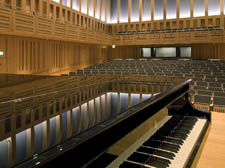|
|
 |
| |
| |
 The Main Hall: a triumph of modern architecture The Main Hall: a triumph of modern architecture |
A triumph of art and architecture
REVIEW: 5 DAYS, 100 CONCERTS
Kings Place
A WARM welcome to Kings Place, a state-of-the-art cultural centre. With two concert halls, exhibition galleries, rehearsal and recording facilities, the 10-storey building gives north London a vital new cultural space.
It will be a base for two leading orchestras: the Orchestra of the Age of Enlightenment and the London Sinfonietta. With its bars and restaurants beautifully situated beside the Battlebridge Basin on Regent’s Canal, it promises also to become a vibrant new meeting place for the community. Permanent moorings for houseboats sit opposite, and there are plans to buy a long boat where events can be staged.
Architect Sir Jeremy Dixon of Dixon Jones has created an attractive and inviting glass frontage on York Way. The entrance foyer opens into a soaring, six-storey, light and spacious atrium surrounded by office space for up to 3,000 workers.
Masterminded by property developer-turned-cultural impresario Peter Millican, it is a superb achievement, the sort of long-term cultural vision seldom found in this country. It is a personal labour of love: Millican is a classical music enthusiast and every detail has been carefully thought out. His property company, Parabola Land, has invested £100million in the site and, with no public subsidy, he has also established a charity, the Kings Place Music Foundation, which will heavily subsidise the rents of the venues and rehearsal spaces, and also the ticket prices.
As chief executive of Kings Place Music Foundation, the innovative and eclectic opening festival demonstrated Millican’s unusual and imaginative approach to programming. With 100 concerts over five days, it was a fascinating parade of varied musical experiences ranging from classical to contemporary, from opera to Indian music.
Below ground, in what is claimed to be the largest underground basement area in London, are the two concert halls. I caught performances by the Classical Opera Company in the Main Hall. It is a triumph of modern architecture: a most glamorous and elegant space, with oak columns and coffered ceilings (all from one 500-year-old German tree) and recessed pale blue walls.
The extraordinarily high ceiling creates a delightful airy and spacious atmosphere. The acoustic, by the experts Arup, is warm, clear and vibrant.
One of the innovative features of the programming was that various strands were entrusted to “curators”, who introduced each concert. Classical Opera Company’s artistic director Ian Page gave us witty and informal introductions to Mozart and Haydn, and the Company’s three talented young singers, Rebecca Ryan, Allan Clayton and Sophie Bevan, accompanied at the piano by Page, tossed off their Haydn arias with aplomb.
It was interesting to note that three of the chosen works were first introduced to London audiences at the Camden Festival in the 1960s and 1970s.
Plans for the future include chamber music, spoken word and contemporary music. Next year there will be weeks dedicated to operas by Haydn (a particular enthusiasm of Millican’s) and Mozart, eight weeks of Beethoven recitals, and a week of music at Christmas inspired by Roald Dahl stories.
Helen Lawrence |
 |
|
 |
|
|
 |
|
 The Main Hall: a triumph of modern architecture
The Main Hall: a triumph of modern architecture






